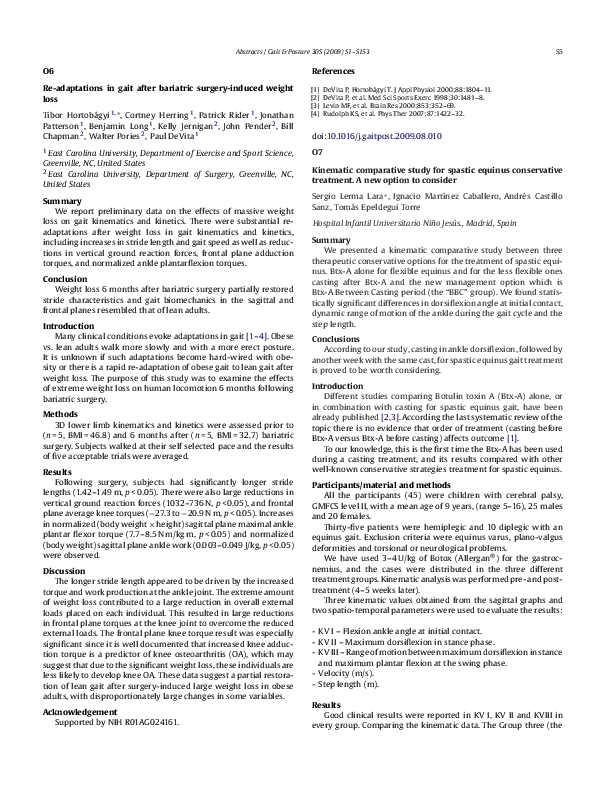Academia.edu no longer supports Internet Explorer.
To browse Academia.edu and the wider internet faster and more securely, please take a few seconds to upgrade your browser.
Re-adaptations in gait after bariatric surgery-induced weight loss
Related Papers
Foot & Ankle International
Effect of Increased Weight on Ankle Mechanics and Spatial Temporal Gait Mechanics in Healthy Controls2012 •
Gait & Posture
Effects of weight loss on foot structure and function in obese adults: A pilot randomized controlled trial2015 •
Journal of obesity
Effects of a Twelve-Week Weight Reduction Exercise Programme on Selected Spatiotemporal Gait Parameters of Obese Individuals2017 •
Objectives. This study was carried out to investigate the effects of twelve-week weight reduction exercises on selected spatiotemporal gait parameters of obese individuals and compare with their normal weight counterparts. Methods. Sixty participants (30 obese and 30 of normal weight) started but only 58 participants (obese = 30, normal weight = 28) completed the quasi-experimental study. Only obese group had 12 weeks of weight reduction exercise training but both groups had their walking speed (WS), cadence (CD), step length (SL), step width (SW), and stride length (SDL) measured at baseline and at the end of weeks 4, 8, and 12 of the study. Data were analysed using appropriate descriptive and inferential statistics. Results. There was significantly lower WS, SL, and SDL but higher CD and SW in obese group than the normal weight group at baseline and week 12. However, the obese group had significantly higher percentage changes in all selected spatiotemporal parameters than the norm...
Obesity Surgery
Foot drop as a complication of weight loss after bariatric surgery: Is it preventable?2007 •
Physical Therapy Reviews
Biomechanical constraints associated with walking in obese individuals2012 •
2023 •
In: A. Kapellos (ed.), The Orators and Their Treatment of the Recent Past. Berlin 2023, 397-411.
De asiento minero a Villa Imperial. Potosí espacio de privilegios y miserias. José F. Forniés Casals y Paulina Numhauser (Eds.) Editorial Universidad de Alcalá, 2021 pp. 121-158.
El bien común y la "cobdicia" de los españoles. Las ordenanzas de minas de Potosí y Porco de 1574 y la de la coca de 1575.2021 •
Una vez superado su comienzo caótico en Potosí, (circa 1545) se observa como los funcionarios reales comenzaron a implementar una serie de medidas destinadas a regular el funcionamiento del asiento minero. Estas disposiciones se diferenciaron marcadamente de las destinadas a normar el trabajo en otras regiones del virreinato peruano. En esta oportunidad estudiaremos dos ordenanzas paradigmáticas, promulgadas en forma paralela por el virrey Francisco de Toledo. Una de ellas es la Ordenanza de Minas de Potosí y Porco del año 1574 y la otra es la Ordenanza de la coca de los Andes del Cuzco del año 1575. Ambos cuerpos legislativos estuvieron destinados a regular realidades diferentes y distantes geográficamente, pero al mismo tiempo estrechamente relacionadas entre sí, pues la coca fue un producto fundamental para el funcionamiento de Potosí. Como comprobaremos las medidas adoptadas en esta oportunidad tuvieron una profunda proyección en la región andina.
RELATED PAPERS
World Journal of Surgery
Correction to: Assessment of Capacity to Meet Lancet Commission on Global Surgery Indicators in the Federal Capital Territory, Abuja, Nigeria2018 •
Projeto História. Revista do Programa de Estudos …
O Nacionalismo Nas Obras Musicais De Alberto Nepomuceno2012 •
Arxiv preprint arXiv:1012.3628
Fast and Power Efficient Sensor Arbitration: Physical Layer Collision Recovery of Passive RFID Tags2010 •
Water
A Hydrological and Geomorphometric Approach to Understanding the Generation of Wadi Flash Floods2017 •
2020 •
2018 •

 Benjamin Long
Benjamin Long